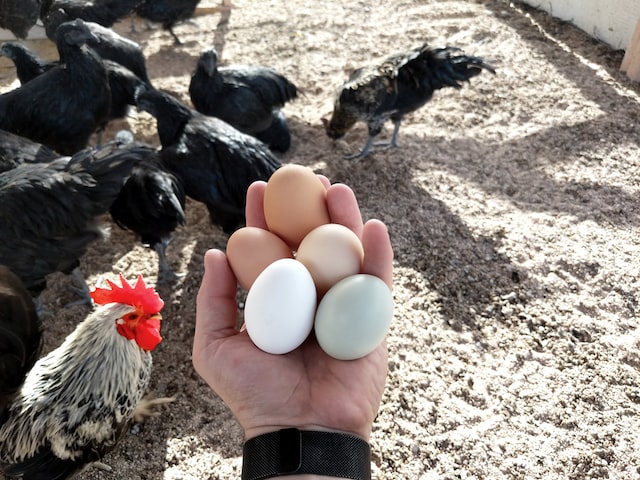Have you ever stopped to wonder why your backyard chickens lay eggs, but they never hatch into chicks?
Well, turns out there’s a science behind it! Chickens aren’t like humans – they can lay unfertilized eggs without any help from roosters or other male chickens.
So what is the secret behind these poultry prodigies and their incredible ability to produce all those delicious omelets and quiches? Read on to find out more about chickens and their enigmatic egg-laying capabilities!
Contents
What are Unfertilized Eggs?
An unfertilized egg is an egg that has not been fertilized by a male. This means the egg does not contain sperm, which is needed for the creation of a new chicken or other species. A female bird can produce unfertilized eggs in her reproductive system without mating with a male bird. These eggs will never develop into chicks because they lack the genetic material from a male parent.
Unfertilized eggs can be safely eaten, just like store-bought eggs, as long as they are cooked thoroughly and handled properly.
The Science Behind Unfertilized Eggs
Unfertilized eggs contain only the genetic material of the female who laid them. This is different than fertilized eggs, which contain two sets of genetic material – one from the female and one from the male who mated with her. Because unfertilized eggs do not contain any sperm, they will never develop into anything else besides an edible food source. In order to lay a fertilized egg, a female bird must mate with a male bird, and this process must happen within 24 hours of laying an egg for it to be considered viable.
Reasons Why Chickens Lay Unfertilized Eggs
Chickens have evolved to lay mostly unfertilized eggs in order to protect their young from predators and environmental threats, such as weather conditions or food shortages that could make it difficult for them to survive until adulthood. Additionally, chickens may lay unfertilized eggs if they are unable to find a suitable mate or if there aren’t enough males around for them to mate with.
In most cases, these females will continue laying unfertilized eggs until they eventually find an appropriate partner and start producing fertile ones instead.
Benefits of Backyard Chicken Keeping and Egg Laying
Backyard chickens can provide families with many benefits, such as pest control and fertilizer production. However, the biggest advantage is being able to enjoy fresh, delicious eggs without having to worry about artificially inseminating hens or bringing in unwanted roosters every breeding season.
Additionally, backyard chickens can help reduce food waste by upcycling kitchen scraps into quality nutrition. Scraps that would otherwise end up in landfills can be used to feed your flock! This means you get more bang for your food buck while also helping reduce your carbon footprint!
Finally, hatching chicks can be a fun activity for kids (or adults!). Everyone will learn more about animal biology and husbandry practices and create memories through hands-on learning that will last well beyond childhood!
How To Tell If An Egg Has Been Fertilized
It is possible to tell if an egg has been fertilized, though it can be difficult.
Fertilized eggs have a small white dot on the surface of the eggshell, indicating the presence of an embryo within. An unfertilized egg will appear perfectly smooth and consistent in color and texture. Occasionally, though, an unfertilized egg will contain a small mass similar to the fertilized egg’s dot. Often, a trained eye can distinguish between these two very similar appearances.
Fertilized eggs have a small white dot on the surface of the eggshell, indicating the presence of an embryo within.
Fertilization occurs when a chicken mates with a rooster, and sperm enters the ovum inside the hen’s oviduct while she is laying her egg. The fertilization process usually takes place minutes after laying begins, so multiple eggs can have different fertilization statuses even if they were laid within seconds of each other.
Candling To Detect Fertilization
Some people may opt to perform a candling test to determine if an egg has been fertilized or not. This technique involves using a bright light source to illuminate an egg from behind and inspecting it for any tell-tale signs of fertility, such as veins or tissue masses inside or on the surface of the shell.
Other Ways To Detect Fertilization
In addition to candling tests, there are other means by which one can determine whether or not an egg has been fertilized. For instance, one may take samples from various points along the reproductive tract during collection to identify any sperm present in the oviduct and any embryos that may have formed before oviposition takes place.
Additionally, when examining freshly laid eggs, one might also look for any changes in their general physical appearance, such as their size and shape. Fertile eggs tend to be slightly longer than infertile ones due to their greater content of liquid content and yolk material inside them.
Lastly, farmers with access to incubation methods can sometimes take advantage of this by allowing freshly laid eggs to remain unrefrigerated and under warm conditions until they hatch – thus confirming whether they are viable or not before they are sold off onto store shelves.
In Summary
So now you know why chickens lay unfertilized eggs and what they are. You’ve even found out a few tests you can do to tell if your hen has laid fertile or infertile eggs.
It’s good to know that having a backyard chicken flock can improve your quality of life in many ways. It’s kind of like having a flock of pets that also give you back an abundance of eggs!
Photo by Daniel Tuttle on Unsplash


